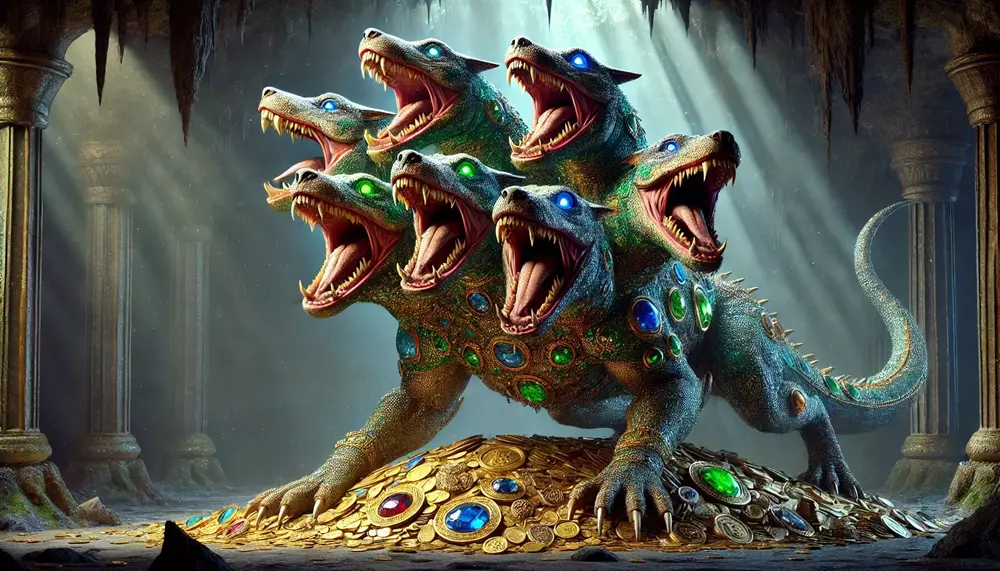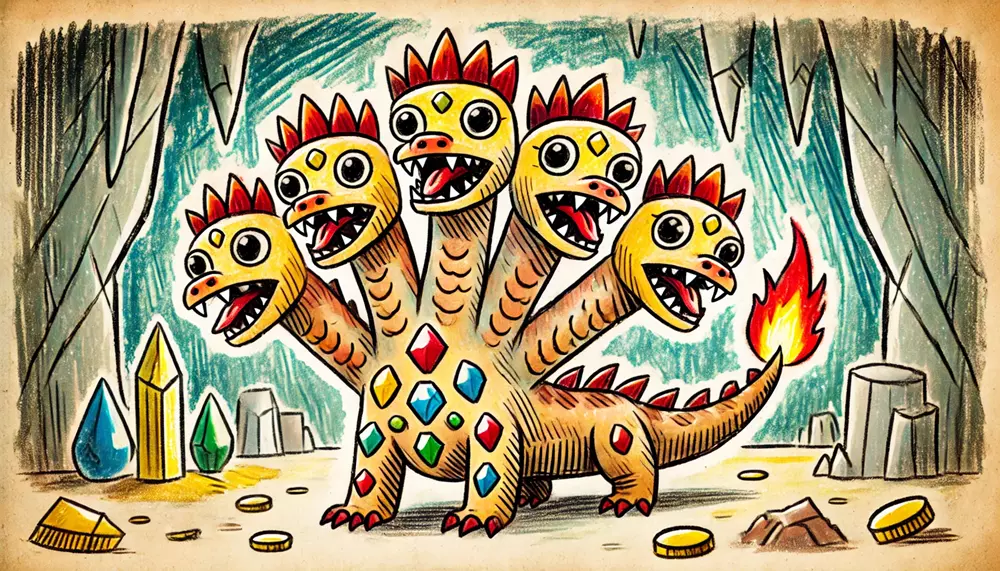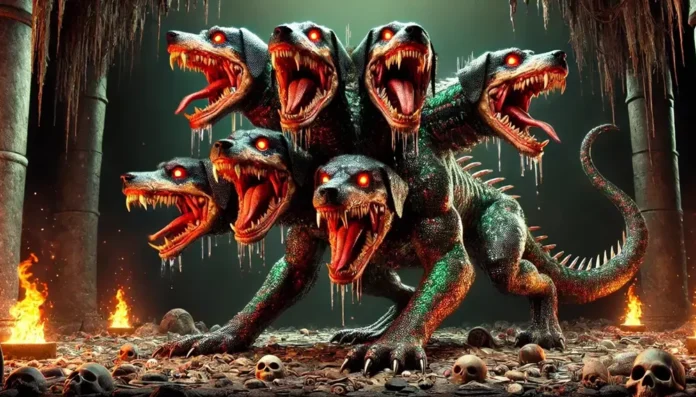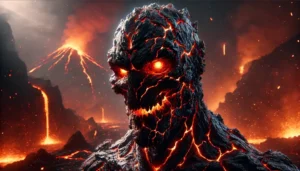Intro/Summary
Teju Jagua isn’t your average lizard. This legendary beast from Guarani mythology boasts seven heads—yes, seven—and an appetite for guarding treasure. Known for its fiery eyes and terrifying presence, Teju Jagua combines the otherworldly with the primeval. But don’t let its monstrous appearance fool you; it’s not all bad. This creature’s myth represents duality: punishment and protection, chaos and harmony.
Described as part lizard, part dog, and entirely fearsome, Teju Jagua is a cultural icon in Paraguayan and Guarani lore. Its seven heads serve as both a warning and a reminder that some forces in nature are best left undisturbed.
History/Origin
Teju Jagua is deeply rooted in Guarani mythology, originating from stories passed down among the Indigenous people of Paraguay and surrounding regions. It’s one of seven monstrous offspring of Tau, the spirit of evil, and Kerana, a mortal woman. This lineage alone makes it a creature of chaos.
According to the myth, Teju Jagua’s creation wasn’t an accident. It was a divine punishment. After Tau and Kerana’s forbidden union, the gods cursed their children to be monstrous beings, each representing a unique terror or flaw. Teju Jagua was made a guardian of treasures, cursed to live among the caves and shadows.
One Guarani elder once said, “Teju Jagua’s eyes burn like the fires of greed it guards.”
These stories weren’t just meant to scare. They taught respect for nature, wealth, and the spiritual balance between good and evil.
Name Meaning
“Teju” translates to “lizard” in Guarani, while “Jagua” means “dog.” The name perfectly describes its hybrid nature: part lizard, part dog. Together, “Teju Jagua” paints an image of a creature rooted in both earthly and mythical domains.
The name also emphasizes its role as a dual-natured beast, symbolizing loyalty and danger.
Appearance
Teju Jagua is as fearsome as it sounds. The creature is often depicted as a massive lizard with seven dog-like heads, each capable of emitting fiery gazes. Its body is said to be covered in scales that shimmer like gemstones, further reinforcing its role as a treasure guardian.
Legends say that when Teju Jagua moves, its seven heads snarl and snap in unison, creating a sound so terrifying it can paralyze anyone who hears it. Despite its menacing look, it is sometimes described as sluggish, moving only to defend its treasure or territory.
Its glowing eyes are said to pierce through the darkest caves, a literal and metaphorical representation of its connection to hidden riches.
Background Story
Teju Jagua’s story begins with divine punishment. Tau and Kerana, the creature’s parents, defied celestial laws, and their children paid the price. Teju Jagua, as the firstborn, was tasked with guarding treasures hidden in caves and beneath the earth. This role is both a curse and a duty.

One legend recounts how a greedy treasure hunter ventured into Teju Jagua’s domain. Drawn by the promise of gold, the hunter ignored the warnings of the locals. As he reached for the treasure, Teju Jagua’s seven heads sprang to life, their fiery eyes illuminating the cave. The hunter fled, abandoning his greed, and the treasure remained untouched.
Cultural Impact
Teju Jagua holds a special place in Guarani folklore. Its dual role as a protector and punisher makes it a symbol of balance. It guards wealth, not out of greed but as a reminder that treasures are often best left untouched.

Festivals in Paraguay and other parts of South America sometimes feature effigies of Teju Jagua. These celebrations honor its place in mythology and teach younger generations about the dangers of greed and the importance of respect.
Artists have also embraced the creature, portraying it in vibrant murals, sculptures, and even modern pop culture adaptations.
Similar Beasts
Teju Jagua shares traits with other mythical creatures across cultures:
Hydra (Greek Mythology): Both are multi-headed guardians. While the Hydra represents chaos, Teju Jagua balances chaos and protection, symbolizing its dual nature.
Nidhogg (Norse Mythology): Like Teju Jagua, Nidhogg lives in the shadows, guarding hidden realms. Both creatures serve as gatekeepers to untouchable domains.
Cerberus (Greek Mythology): With its multiple heads and guardian role, Cerberus mirrors Teju Jagua as a protector of sacred places.
These comparisons highlight universal themes of guardianship and the boundary between human greed and the sacred.
Religion/Ritual
Teju Jagua isn’t just a creature of legend; it’s a spiritual symbol. In Guarani culture, it embodies both fear and reverence. Rituals involving Teju Jagua often include offerings to appease the beast or to ensure safe passage through its territory.
Some believe that invoking Teju Jagua’s name during rituals can protect against greed or dishonesty, channeling its guardian energy for good.
“Oh Teju Jagua, guardian of treasures, keeper of secrets, may your fire illuminate but never harm.”
Scientific or Rational Explanations
While Teju Jagua is firmly rooted in mythology, some theories suggest it may have been inspired by real animals. Giant lizards, like the tegu lizard native to South America, share some physical traits with the creature. Tegus are large, powerful reptiles with a striking appearance, possibly giving rise to the myth.
Additionally, the caves and regions associated with Teju Jagua often contained natural treasures like gemstones or gold. The idea of a guardian creature may have been a way to deter thieves and preserve these riches.
Modern Cultural References
Teju Jagua has transcended its mythological roots and appeared in modern culture:
- Books: The creature appears in Latin American folklore collections, often highlighted for its seven heads and treasure-guarding role. For example, it features prominently in Paraguayan mythology anthologies.
- Video Games: Games like Mythical Guardians include a boss character inspired by Teju Jagua, complete with glowing eyes and multi-headed attacks.
- Television Shows: In certain South American children’s programs, Teju Jagua is reimagined as a less terrifying, more mystical creature, aimed at introducing mythology to younger audiences.
- Festivals: Paraguayan cultural festivals celebrate Teju Jagua, with costumes and parades showcasing the creature’s mythic grandeur.
- Comics: Independent comics have depicted Teju Jagua as a guardian-like figure, blending its traditional myth with modern storytelling.
Conclusion
Teju Jagua stands as a testament to the richness of Guarani mythology. Its seven heads, fiery eyes, and guardian role make it a powerful symbol of balance and respect for the sacred. Whether guarding treasures or teaching lessons about greed, it continues to captivate imaginations and remind us of the complex interplay between humanity and the forces of nature.
“Guarded by seven heads and a fiery gaze, Teju Jagua watches over the world’s hidden secrets.”




